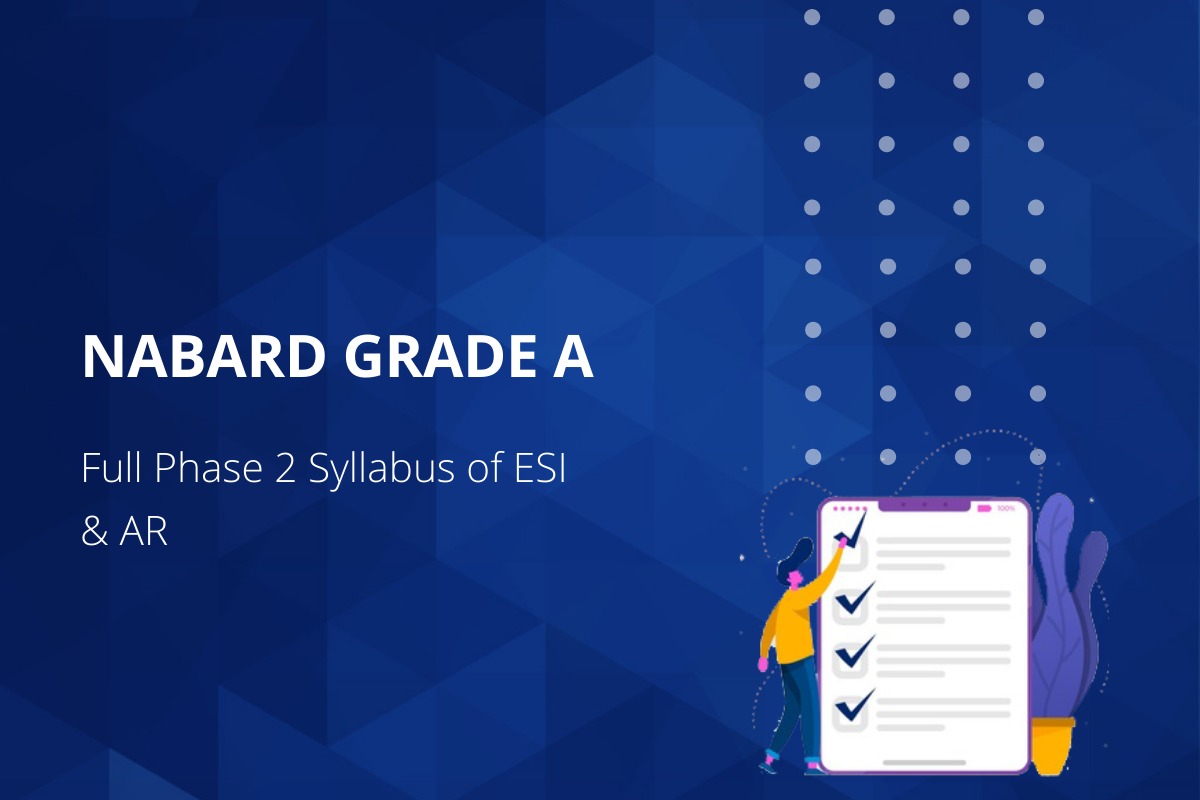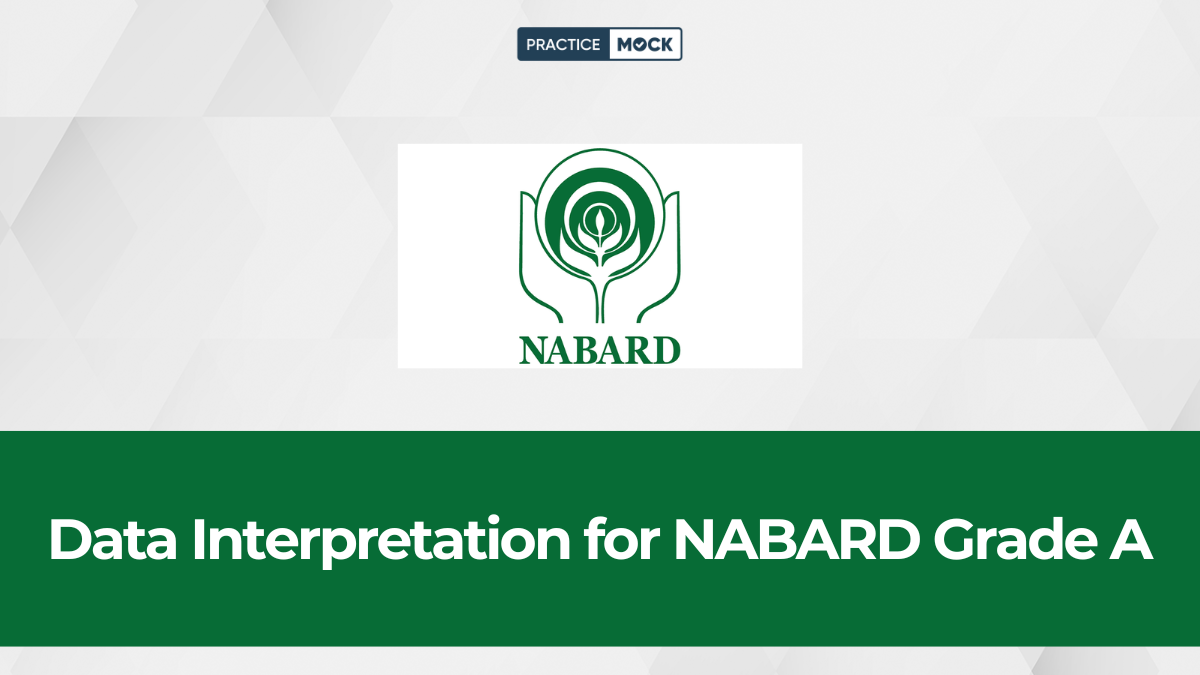

NABARD Grade-A Exam 2021: It was seven days ago when the National Bank for Rural and Agricultural Development announced the recruitment for Grade A officers.
The changes in the examination pattern are quite evident from the notification. Many new things have been added as per the requirement of NABARD. However, the phase-2 syllabus is nearly the same, but it is a very vast syllabus to be covered as usual.


Phase-2 Economic and Social Issues Syllabus with Sub-topics
Nature of Indian Economy
- Structural and Institutional features
- Economic underdevelopment
- Opening up the Indian Economy
- Globalisation
- Economic Reforms in India
- Privatisation
Inflation
- Trends in Inflation & their Impact on National Economy and Individual Income
Poverty Alleviation and Employment Generation in India
- Rural and Urban
- Measurement of Poverty
- Poverty Alleviation Programmes of the Government
Population Trends
- Population Growth and Economic Development
- Population Policy in India
Agriculture
- Characteristics / Status – Technical and Institutional changes in Indian Agriculture
- Agricultural performance
- Issues in Food Security in India
- Non-Institutional and Institutional Agencies in rural credit
Industry
- Industrial and Labour Policy
- Industrial performance
- Regional Imbalance in India’s Industrial Development
- Public Sector Enterprises
Rural banking and financial institutions in India
- Reforms in Banking/ Financial sector.
- Globalisation of Economy
- Role of International Funding Institutions
- IMF & World Bank
- WTO
- Regional Economic Co-operation
Social Structure in India
- Multiculturalism
- Demographic trends
- Urbanisation and Migration
- Gender Issues Joint family system
- Social Infrastructure
- Education
- Health and Environment
Education
- Status & System of Education
- Socio-Economic Problems associated with Illiteracy
- Educational relevance and educational wastage
- Educational Policy for India
Social Justice
- Problems of scheduled castes and scheduled tribes
- Socio-economic programmes for scheduled castes and scheduled tribes and other backward classes
Positive Discrimination in favour of the under privileged
- Social Movements
- Indian Political Systems
- Human Development
Current Economic & Social Issues
PracticeMock has launched NABARD Grade B notes after analysing the need for aspirants to have access to the otes of all the topics as the syllabus is very vast and it’s nearly impossible to keep making notes for yourself.
Benenfits of NABARD Grade B Notes:
-1st Chapter Free
-Economic & Social Issues (ESI) & Agriculture & Rural Development (ARD) covered
-Comprehensive Coverage of Current Affairs with reference to ESI & ARD
Syllabus for Phase-2 Agricultural and Rural Development with Sub-topics
The syllabus for agriculture and rural development is going to be separate.
Agriculture
- Definition
- Meaning and its branches
- Agronomy: definition, meaning and scope of agronomy.
- Classification of field crops.
- Factors affecting crop production, Agro Climatic Zones; Cropping Systems: Definition and types of cropping systems.
- Problems of dry land agriculture; Seed production, seed processing, seed village; Meteorology: weather parameters, crop-weather advisory; Precision Farming, System of Crop Intensification, organic farming;
a) Soil and Water Conservation
Major soil types, soil fertility, fertilisers, soil erosion, soil conservation, watershed management;
b) Water Resource: Irrigation Managemen
types of irrigation, sources of irrigation, crop-water requirement, command area development, water conservation techniques, micro-irrigation, irrigation pumps, major, medium and minor irrigation.
c) Farm and Agri Engineering
Farm Machinery and Power, Sources of power on the farm- human, animal, mechanical, electrical, wind, solar and biomass, bio fuels, water harvesting structures, farm ponds, watershed management, Agro Processing, Controlled and modified storage, perishable food storage, godowns, bins and grain silos.
d) Plantation & Horticulture:
Definition, meaning and its branches. Agronomic practices and production technology of various plantation and horticulture crops. Post-harvest management, value and supply chain management of Plantation and Horticulture crops.
e) Animal Husbandry:
Farm animals and their role in Indian economy, Animal husbandry methods in India, common terms pertaining to different species of livestock, Utility classification of breeds of cattle. Introduction to common feeds and fodders, their classification and utility. Introduction to poultry industry in India (past, present and future status), Common terms pertaining to poultry production and management. Concept of mixed farming and its relevance to socio-economic conditions of farmers in India. Complimentary and obligatory nature of livestock and poultry production with that of agricultural farming.
f) Fisheries:
Fisheries resources, management and exploitation – freshwater, brackish water and marine; Aquaculture- Inland and marine; biotechnology; post-harvest technology. Importance of fisheries in India. Common terms pertaining to fish production.
g) Forestry:
Basic concepts of Forest and Forestry. Principles of silviculture, forest mensuration, forest management and forest economics. Concepts of social forestry, agroforestry, joint forest management. Forest policy and legislation in India, India State of Forest Report 2015. Recent developments under Ministry of Environment, Forest and Climate Change.
h) Agriculture Extensions:
Its importance and role, methods of evaluation of extension programmes, Role of Krishi Vigyan Kendra’s (KVK) in dissemination of Agricultural technologies.
i) Ecology and Climate Change:
Ecology and its relevance to man, natural resources, their sustainable management and conservation. Causes of climate change, Green House Gases (GHG), major GHG emitting countries, climate analysis, distinguish between adaptation and mitigation, climate change impact to agriculture and rural livelihood, carbon credit, IPCC, UNFCCC, CoP meetings, funding mechanisms for climate change projects, initiatives by Govt of India, NAPCC, SAPCC, INDC.
j) Present Scenario of Indian Agriculture and Allied activities
recent trends, major challenges in agriculture measures to enhance viability of agriculture. Factors of Production in agriculture; Agricultural Finance and Marketing; Impact of Globalization on Indian Agriculture and issues of Food Security; Concept and Types of Farm Management.
Syllabus for Rural Development
Concept of Rural Area, Structure of the Indian Rural Economy Importance and role of the rural sector in India
- Economic
- Social and Demographic Characteristics of the Indian rural economy
- Causes of Rural Backwardness
Rural population in India
- Occupational structure
- Farmers
- Agricultural Labourers
- Artisans
- Handicrafts
- Traders
- Forest dwellers/tribes and others in rural India
- Trends of change in rural population and rural work force
- problems and conditions of rural labour
- Issues and challenges in Handlooms Panchayati Raj Institutions – Functions and Working
MGNREGA, NRLM – Aajeevika, Rural Drinking water Programmes, Swachh Bharat, Rural Housing, PURA and other rural development programmes.
Note: The illustrative syllabus for Main Examination – Paper II for Grade A (RDBS)- Specialised Disciplines at Sr. No. (ii) to (xi) in Table-1 and Grade A (Rajbhasha) will be uploaded on NABARD’s website
Recent Posts
How to clear IBPS PO 2025 without coaching?
How to clear IBPS PO 2025 without coaching? Know about the IBPS PO 2025 online…
SSC CGL AAO Salary 2025: In-hand, Job Profile, Career Growth
In this blog, we have provided the details related to the SSC CGL AAO Salary…
Success Story of Lagnojita Sikdar, Cleared IBPS Clerk
In an interview with PracticeMock, Lagnojita Sikdar shared her journey of clearing the IBPS Clerk…
SBI CBO vs SBI PO: Check Difference in Job Profile, Salary, and Which is Easy to Crack?
In this article, we provide the difference between SBI CBO and SBI PO Job Profile,…
SBI CBO Syllabus 2025 Released, Check Exam Pattern
SBI CBO Syllabus 2025, check latest Exam Pattern: Know the syllabus and exam pattern for…
Do RBI Grade B Officers Get Foreign Posting and Trips?
This blog answers if RBI Grade B Officers get foreign trips, how often they occur,…



